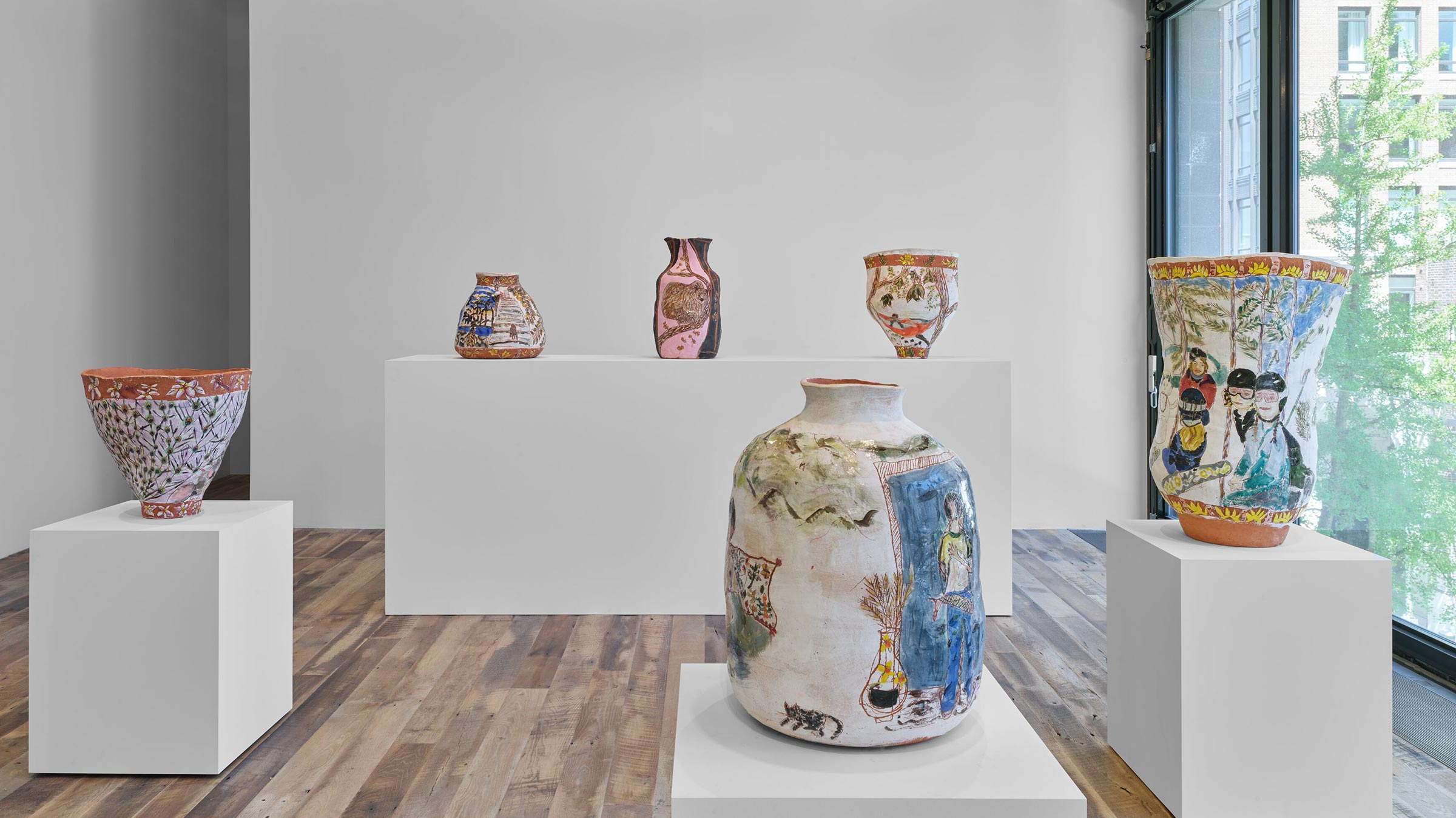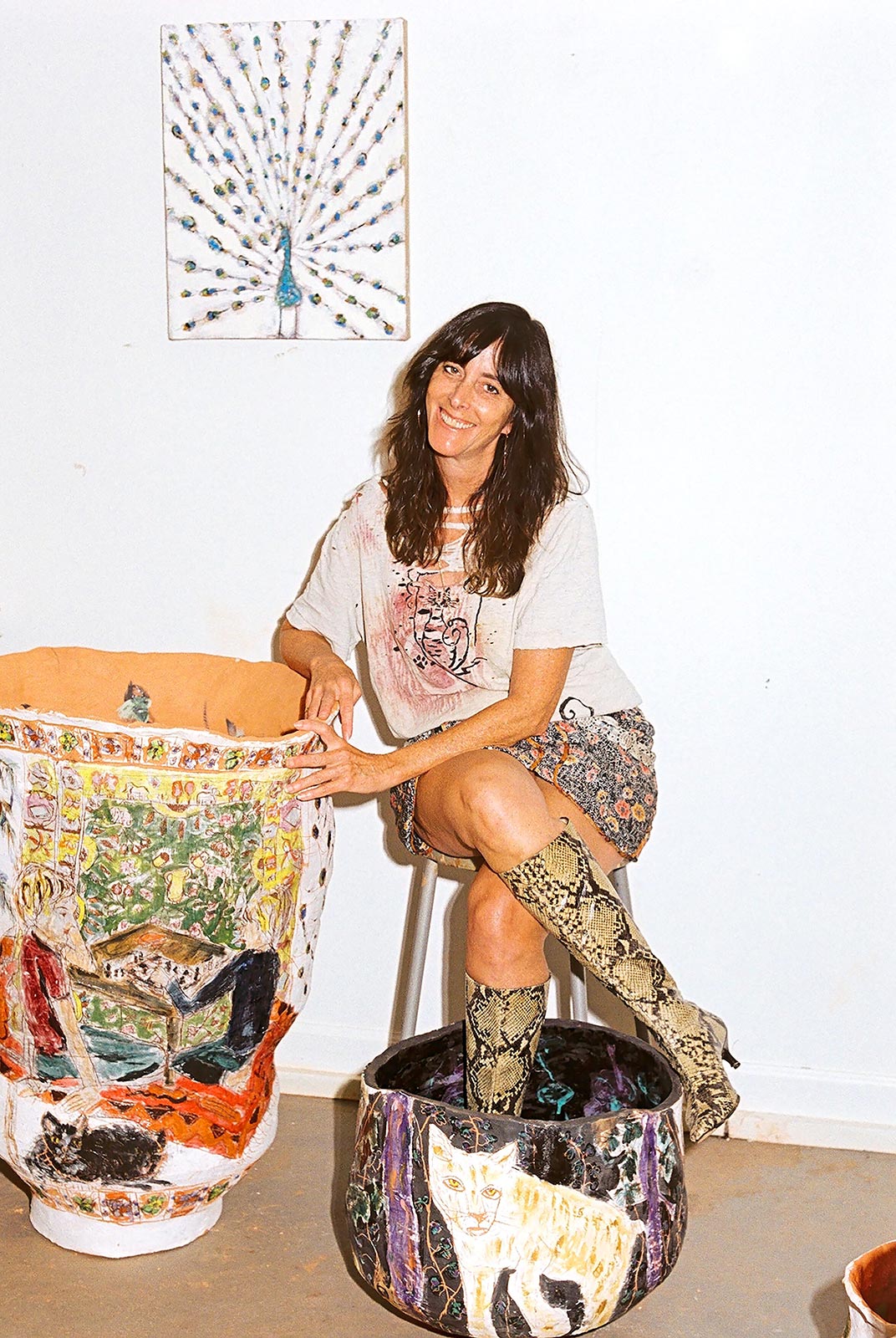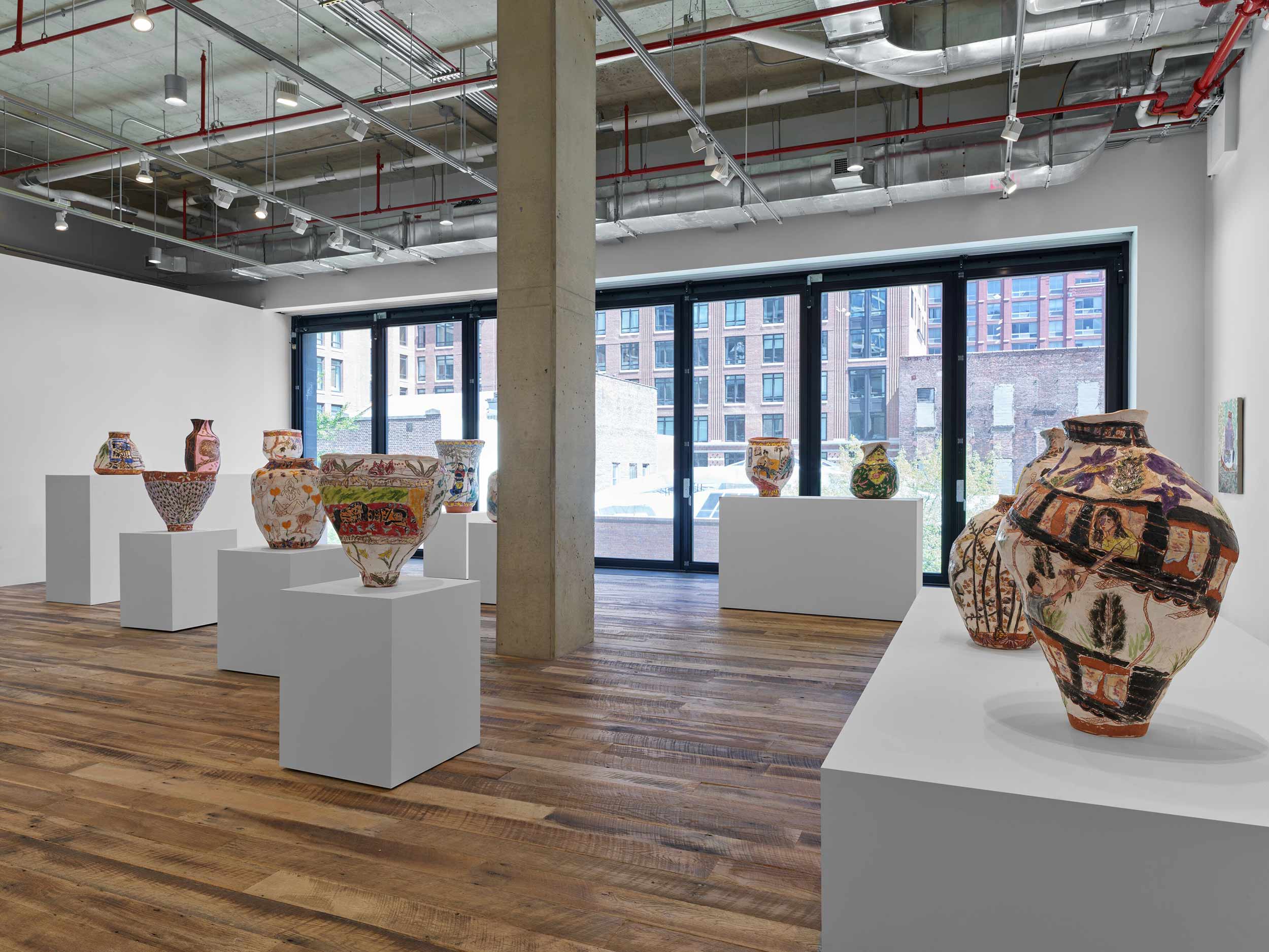On the occasion of Rochlin’s exhibition ‘Paintings on Clay’ at Hauser and Wirth, the two artists talk about friendship, collaboration, and the potency of nature
Jennier Rochlin and Jennifer Guidi talk almost everyday. The two LA-based artists share a name, of course; they also share having twins—something Rochlin playfully blames (and thanks) Guidi for. They both work with the earth—with clay and sand respectively—but to, at first glance, wildly different ends: Rochlin’s been preoccupied with making large-scale, image-covered painted pots for the past several years, while Guidi makes mandala-like canvases that frequently exist somewhere between landscape and abstraction.
Recently, however, Guidi put some paint down on Rochlin’s Honey Pot, laying out an anatomy-textbook-style diagram of a vagina for the two-foot-tall ceramic vessel that is part of Rochlin’s exhibition Paintings on Clay on view at Hauser and Wirth in Chelsea. The show collects a dozen hand-sculpted terracotta pots, plus paintings inspired by them, that are enlivened with scenes from everyday life, with collaboratively drawn genitals, film-reel-like graphics, and bruise-colored bite marks.
It’s clear why and how they can talk everyday: between them ideas flurry and grow; they complete each other’s sentences; they keep each other curious about how a practice can shift and evolve. Together, we discuss collaboration and kink, process and pottery, narrative and nature. It’s a glimpse into the active, funny, salient world glimmering on the terracotta surfaces in Paintings on Clay.
Drew Zeiba: You worked with several others, including Jennifer Guidi, in one of the pots in Paintings on Clay. How’d that happen?
Jennifer Rochlin: So that that piece was kind of a companion piece to this other work that I did, which was Cock Pot for the show based on Brigid Berlin that Alison Gingeras curated last summer. And I didn’t know much about Brigid Berlin—it was an homage to her, and I looked her up and she had done this thing called a Cock Book where she would take a sketchbook around to different bars and have artists draw on it. So I was like, Oh, I’ll make a Cock Pot and have my artist friends draw on it. That was super fun. And so then for this show, I wanted to make a companion piece to that. I came up with Honey Pot to have my women artist friends draw vaginas on a pot. Jen’s collaboration was great. I had the pot in my car because I was already taking it around to friends to draw on, and Jen was helping me with the installation for my show—she’s really good at that and I’m not very good at that—so I was there at her studio for hours. I brought the pot in and she had time.
Jennifer Guidi: I probably had the longest amount of time to work on it. I was working from a medical anatomy book. It was funny to look something up and be more scientific about that drawing. But we were both talking about when Rochlin did the Cock Pot, I was having a dinner party, and she asked if she could bring it over, so that all of us could work on it. It was mostly artists. It was this idea of collaboration and this community of artists that we have here, and the fun of contributing to Rochlin’s pot, where there are so many artists. It was this enjoyable moment of just drawing on someone else’s vessel.
Jennifer Rochlin: Jen was saying that it was like how when you’re in high school or junior high, you used to draw on people’s casts. Like, a way to leave your autograph or make a little drawing like in a not in a sort of…
Jennifer Guidi: …not a precious thing.
Jennifer Rochlin: Even though it’s funny, because it ends up being an artwork. But because so many people are drawing on it, you know that your [drawing] is just one part of a larger thing. It’s not like if I said to you, ‘Let’s you and I make a collaboration together,’ which would have a whole other setup. Also, bringing it to a party is a casual way for people to draw on it versus someone like, ‘Oh, come to my studio, come draw on my work.’ I think the way I brought it around to people created this element of fun.
“I put people that are important to me, or things that I want to commemorate, or what I find is a really emotional time or a really fun time or a memory that I had. That’s what ends up on the pots.”
Drew: The collaboration has me thinking, Jennifer Rochlin, about how in the imagery you’re representing real people and moments from your life. What was it like involving people in that way? Were there any controversies?
Jennifer Rochlin: Oh, I have people vying to get on my pots. They’ll send me a cute picture of them and their dogs and be like, ‘Can I be on your pot?’ And then, Jen—I always share these too-private things—but Jen and I were just talking about this. She was like, ‘You know you really like a guy when he makes it on a pot.’ I put people that are important to me, or things that I want to commemorate, or what I find is a really emotional time or a really fun time or a memory that I had. That’s what ends up on the pots.
Jennifer Guidi: It’s the story of your life. You’re recording personal histories.
Jennifer Rochlin: Yeah, and that’s why it was fun to turn to having my friends who are artists draw on the work. It was like, Oh, instead of me, putting an image of you on the pot, you’re gonna have a physical presence. It’s a different layer to the ways to contribute.
Drew: This has me thinking about the role of sexuality in the work. Not just the Cock Pot or Honey Pot, but also some of the scenes of nudes in bed or people making out.
Jennifer Rochlin: It’s funny, because it kind of ebbs and flows—like what’s going on in my life. When I was making this work, I happened to reengage in a passionate affair with this younger guy who I had been involved with five years before. He came back to town, and it’s a really special relationship that brings out all these feelings in me. We were seeing each other for six months, the whole time I was making the show. And it’s not without its complete angst, I guess, this relationship. A lot of the work was made under that umbrella, and when I put that part of us having sex on the pot, I was like, Oh, God, don’t do it. Don’t do it. Don’t do it. Don’t… fuck it’s on there! It’s almost like I couldn’t help it. Afterwards, I’m always a little embarrassed.
Jennifer Guidi: You’re not censoring life. That’s a part of life. I think it’s nice that you have the freedom to do that.
Jennifer Rochlin: The work that I made the year before didn’t really have much of that at all. So it just happened to be what was happening at the time. And the biting did come initially from a sexual thing, which became unimportant, kind of—but it’s always there. I do paint them to look bruised, so there’s always a little element of kink in there, whether the viewer knows or not. Maybe I like that it’s a little subversive.
Drew: I’m thinking back to this diagram of the vagina. Jen Guidi, when I look at your paintings, I first almost see them as diagrammatic or schematic abstractions, and then other features, like landscapes or diffuse light, start to resolve for me. Jennifer Rochlin, this in some sense reminds me of these film-reel-like moments on some of the pots, where the scenes are organized in other visual containers. How do you approach composition?
Jennifer Guidi: I definitely like to play between abstraction and representation, where abstraction becomes more of an inner landscape. For me, it’s that journey of self-exploring. And my landscapes are talking about that same thing. I like being able to go back and forth between those two worlds that feel like the same world to me, where landscape is about going out into nature and finding oneself and this idea of searching for inner peace. I think that I’m playing with both of those worlds or narratives. What do you think?
Jennifer Rochlin: I like that. I used to teach painting and drawing. And I have so many friends that are abstract painters. And I would just always be like, I don’t understand, how do you make an abstract painting? I would even have a lesson where my students would have to make an abstract painting, but I was like, I just don’t understand, how do you know what’s what? I was so based in image, always so based in image. But I think I have pattern. And I have decorative elements and I have repetition, which could be forms of abstraction. But I think everything for me comes from an image. In one part of my painting, Madeline, the director at Hauser and Wirth was like, ‘I really liked this abstract moment.’ I was like, ‘Ooh! There’s an abstract moment?’ I think I’m still trying to understand you abstract artists, you abstract painters. What got you into abstraction?
Jennifer Guidi: What got me into abstraction?
Jennifer Rochlin: The back of the rug?
Jennifer Guidi: The back of the rugs. But I didn’t want to record a story in that way. Like I didn’t want to draw people or things necessarily because I think it was more about the repetition of making things and mark-making that I wanted to break down and just have it be about that. But it took a long time to think that that was okay, that I could leave it as more of a minimalist image. And working on the back… Rochlin and I both have these moments when textiles were very important and a way of creating paintings, where she was making paintings of rugs and I was taking photos of the backs of rugs and looking at the stitches and painting those stitches. That’s what led me into finally making abstract paintings.
Jennifer Rochlin: That’s funny. Same for sand. Why did you start using the sand?
Jennifer Guidi: When I would see paintings with sand in it—which was something I was always attracted to, that texture—I would ask: How could someone make a painting with just sand? Was that possible? So it was another way of taking those little elements, whether it’s pigment or dots, and putting them together and being able to make a solid. Then also to be able to mark into it was very interesting
Jennifer Rochlin: Jen will use a tool or hand to dig into the sand in the same way that I use a terracotta clay, then I put a white underglaze, and then I peel away that layer. It’s called sgraffiti, where I draw into the clay. So we’re both revealing something in our process by using the elements…
Jennifer Guidi: …like carving into the earth in a way, scratching the surface.
Drew: Earth and sand. It makes me think about the presence of nature in both of your work. What does nature mean for you?
Jennifer Rochlin: I’m obsessed with nature. I live in this area called Altadena which is right against the foothills. And I moved here because of that. About 100 feet from my house is a trail. So I am out on that trail as much as I can be—almost every day—either hiking or mountain biking. I need it, I literally need it for my sanity. And that’s why I moved here. Years ago, 20 years ago, I was like, Am I moving to New York? Or am I moving to LA? The reason I moved to California was because I knew the proximity to nature that I would have and how easy it would be to get out.
I got into clay by accident by teaching at this job where they asked me if I would start a ceramic program when I had never worked with clay and I was like, ‘Yeah, I’d love that. That sounds so fun.’ But I do think all of the love of the texture comes from all of the texture that’s in nature—the rocks and the dirt and the gravel and the leaves and the dried leaves and the trees peeling and the bark. Constantly seeing that change through the seasons. That has a huge impact on me and on my work.
Jennifer Guidi: I think we share that.
Jennifer Rochlin: There’s no bigger mood booster. I feel like I should work for the National Park Service or something because if friends are depressed, I’m always like, ‘You’ve got to come over, let’s go for a hike.’ People don’t know about how great it is.
Jennifer Guidi: That’s true. And I’m up against Griffith Park, so it’s similar where I live very close to trails. Rochlin and I go for hikes. Sometimes we’ll walk barefoot for some grounding.
Jennifer Rochlin: I still want to be a plein air painter. I tried it a few times and it’s really fun. I want to be one of those people that goes out with their easel.
Jennifer Guidi: I have my landscape easel. Maybe we should do that.











